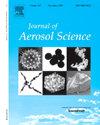Algorithm for improving the sizing accuracy in real-time bioaerosol single particle mass spectrometer
IF 3.9
3区 环境科学与生态学
Q2 ENGINEERING, CHEMICAL
引用次数: 0
Abstract
The newly developed bioaerosol single particle mass spectrometer (Bio-SPAMS) has been innovatively designed for its optical sizing system. The first laser beam in the previous single particle mass spectrometer was split into near distance double beams, similar to the design of APS (Aerodynamic Particle Sizer) and SBS-LIBS (Single Beam Splitting-Laser Induced Breakdown Spectroscopy). All the particles focused by the aerodynamic lens can be sized and got number concentration statistic. However, due to the imperfect beam quality and the large scattering intensity of the large-sized particles, there may be some noise in the scattered signals, particle diameter measured by this sizing system was often larger than actual value if the same trigger threshold was set. In this study, when measuring PSL microspheres with diameters of 1.9, 3.1, and 4.9 μm, the identification rates of the fixed threshold algorithm were only 75.25%, 55.26%, and 0.27%, respectively. To address such issue, we developed a dynamic threshold waveform recognition algorithm based on field programmable gate array (FPGA), which could process the photoelectric signals collected by a photomultiplier tube (PMT) in real time. The algorithm can dynamically adjust the trigger threshold of the collected scattered signals and accurately calculate the interval time between the near distance double beam. For PSL microspheres with diameters of 1.9, 3.1, and 4.9 μm, the accuracy of the dynamic threshold algorithm increased by 19.09%, 25.72%, and 88.20%, respectively. This algorithm effectively solves the problem of particle sizing deviation, and improves the particle size measurement accuracy of the bioaerosol mass spectrometer in a wide particle size range from 0.3–6 μm.
求助全文
约1分钟内获得全文
求助全文
来源期刊

Journal of Aerosol Science
环境科学-工程:化工
CiteScore
8.80
自引率
8.90%
发文量
127
审稿时长
35 days
期刊介绍:
Founded in 1970, the Journal of Aerosol Science considers itself the prime vehicle for the publication of original work as well as reviews related to fundamental and applied aerosol research, as well as aerosol instrumentation. Its content is directed at scientists working in engineering disciplines, as well as physics, chemistry, and environmental sciences.
The editors welcome submissions of papers describing recent experimental, numerical, and theoretical research related to the following topics:
1. Fundamental Aerosol Science.
2. Applied Aerosol Science.
3. Instrumentation & Measurement Methods.
 求助内容:
求助内容: 应助结果提醒方式:
应助结果提醒方式:


